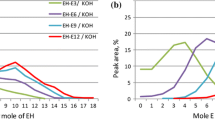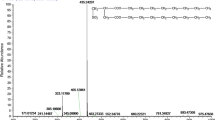Abstract
Two types of N-substituted long-chain alkanolamine surfactants were prepared. Firstly, octadecyl glycidyl ether was synthesized from octadecanol and epichlorohydrin. Subsequently, a ring-opening reaction of the epoxide ring of octadecyl glycidyl ether was performed with monoethanolamine and diethanolamine to synthesize bis(octadecyloxy)-2- hydroxypropylmonoethanolamine (D-MEA)and octadecyloxy-2-hydroxypropyldiethanolamine(M-DEA) without catalyst at 60 °C, respectively. And their corresponding tertiary amine salts bis(octadecyloxy)-2-hydroxypropylmonoethanolamine hydrochloride (D-MEAS) and octadecyloxy-2-hydroxypropyldiethanolamine hydrochloride (M-DEAS) were attained by neutralization with hydrochloric acid. The study on these four surfactants included their surface active properties, foaming abilities, emulsifying properties, lime-soap dispersion abilities and wetting abilities. The results show that D-MEAS possesses the best surface active property and lime-soap dispersion ability. D-MEA has better foaming ability and foaming stability. The wetting ability of M-DEA and the emulsifying property of M-DEAS are prominent.




Similar content being viewed by others
References
Schwartz AM, Perry JW (1949) Surface active agents: their chemistry and technology, vol I. Interscience Publishers, New York
Kang Y, Cai XJ (2012) Research development of alkanolamide surfactant. Adv Fine Petrochemicals 40:49–61
Adewuyi A, Oderinde RA, Rao BVSK, Prasad RBN (2012) Synthesis of alkanolamide: a nonionic surfactant from the oil of Gliricidia sepium. J Surfact Deterg 15:89–96
Liu NN, Xia YM, Gu ZM (2012) Synthesis and properties of palmitoyl ethanolamide and palmitoyl diethanolamide. Fine Chemicals 29:6–9
Kolancilar H (2004) Preparation of laurel oil alkanolamide from laurel oil. J Am Oil Chem Soc 81:597–598
Mishra S, Tyagi VK (2007) Ester quats: the novel class of cationic fabric Softeners. J Oleo Sci 56:269–276
Geng T, Li QX, Jiang YJ (2011) Esterification of stearic acid with triethanolamine over zirconium sulfate supported on SBA-15 mesoporous molecular sieve. J Surf Deterg 14:15–22
Geng T, Li QX, Jiang YJ, Wang W (2010) Synthesis of stearic acid triethanolamine ester over solid acid catalysts. Chin Chem Lett 21:1020–1024
Masoumi HRF, Kassim A, Basri M, Abdullah K (2011) Determining optimum conditions for lipase-catalyzed synthesis of triethanolamine (TEA)-based esterquat cationic surfactant by a Taguchi robust design method. Molecule 16:4672–4680
Liu Wen J, Sun YQ, Liu XD (2012) Synthesis and performance of polyethoxy ester quaternary ammonium salts. China Surf Deterg Cosm 42:34–38
Li PX, Dong CC, Thomas RK, Wang YL (2011) Adsorption of gemini surfactants with dodecyl side chains and different spacers, including partially fluorinated spacers, on different surfaces: neutron reflectometry results. Langmuir 27(5):1844–1852
Rosen MJ (1993) Gemini: a new generation of surfactants. Chem Tech 23:30–34
ASTM D 1173-53 (1992) Volume 15.04, Annual book of ASTM standards, American Society for Testing Materials, Philadelphia, PA
Xu RF, Xu HJ, Xu H, Geng H, Chen L (2012) Synthesis and properties of 4,4′-di(n-tetradactyl) diphenylmethane disulfate salt. Appl Chem Ind 41:317–320
Zhu YP, Masuyama A, Okahara M (1990) Preparation and surface active properties of amphipathic compounds with two sulfate groups and two lipophilic alkyl chains. J Am Oil Chem Soc 67:459–463
McCutecheon JW (1950) Synthetic detergents. McNair-Dorland , New York
Metcalfe LD (1984) The analysis of cationic surfactants. J Am Oil Chem Soc 6:363–366
Rosen MJ (2001) Surface and interfacial phenomena, 2nd edn. Wiley, NY
Tehrani-Bagha AR, Holmberg K (2010) Cationic ester-containing gemini surfactants: physical-chemical properties. Langmuir 26(12):9276–9282
Xu Q, Cao ML, Ma WH, Sun DF, Wang W (2004) Synthesis and properties of dissymmetric gemini quaternary ammonium salts cationic surfactants. China Surf Deterg Cosm 34:280–282
Wang Y, Xia LS, Xia YT (2012) Synthesis and properties of alkanolamide polyglycerol ethers. Chem Eng 40:49–61
Terri A, Camesano RN (2000) Micelle formation and CMC of gemini surfactants: a thermodynamic model. Colloids Surf A 167:165–177
Author information
Authors and Affiliations
Corresponding author
About this article
Cite this article
Zhang, Y., Xu, Y., Qiu, S. et al. Synthesis and Properties of Mono or Double Long-Chain Alkanolamine Surfactants. J Surfact Deterg 16, 841–848 (2013). https://doi.org/10.1007/s11743-013-1488-7
Received:
Accepted:
Published:
Issue Date:
DOI: https://doi.org/10.1007/s11743-013-1488-7




